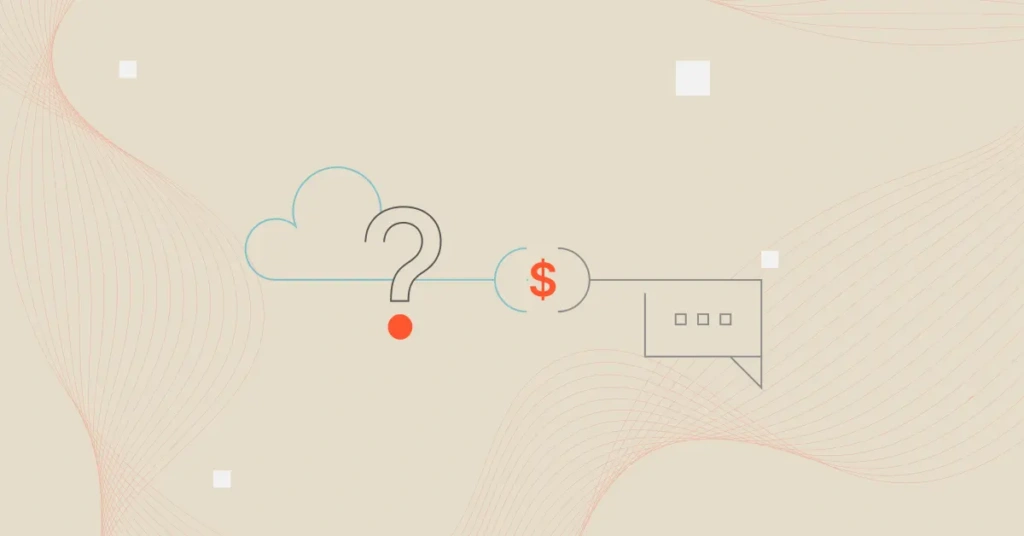As an engineer at a SaaS company, it’s your job to build the software products that make your company profitable. Problem-solving is what you love to do, and it’s a wonderful feeling when you can create something that makes a positive difference for your company.
One of the less enjoyable aspects of your job is probably fielding questions from finance:
- Why did you choose to build the product this way?
- How much should we commit to this provider’s discount plan?
- What do you expect costs to be for the next quarter [or year]?
If you’re anything like most engineering teams we work with, it’s not easy to answer questions like these; it can also feel like a burden to have to press pause on your important projects to try and come up with answers.
The good news is that you can apply your problem-solving skills to this situation as well. It will take a bit of effort upfront, but soon you’ll be fielding questions easily — without sacrificing the time and energy you’d rather spend on your projects.
How To (Confidently!) Answer Tough Cloud Cost Questions From Finance
Finance questions usually relate to one of three things: 1) basic reporting 2) future predictions 3) explanations regarding specific occurrences.
Basic Reporting Questions
- What were our costs for this specific time period?
- How were those costs proportioned between OpEx, COGS, and other expense categories?
- How were costs proportioned between product A versus product B (etc.)?
- What do costs look like with and without commitment amortizations?
- May we have access to the data for this specific project or that time period?
Future Predictions Questions
- How should we design next year’s budget?
- How much will we spend next year on this vendor compared to that vendor?
- We’re about to renew a contract with this vendor, and they’d like us to prepay a certain amount. How much should we pay in advance?
- How much will product A cost versus product B over the next one to two years?
- How will spending on this vendor change when you launch that new product/project/feature?
Requests For Explanations
- We didn’t perform to the budget for a certain time period. Why?
- We’ve noticed a change in [x] metric or cost. What’s causing it?
How do you answer these questions (without taking a shot in the dark?)
At first glance, you’ll notice that some of the above questions are far trickier to answer than others.
For example, you can easily hand over data when requested or look up how much you spent in a given quarter, but you probably won’t have an answer ready to go if someone asks how much you expect to spend on one product compared to another two years down the line. There are many variables that could affect your answer.
The same goes for nearly all the questions you’ll encounter in the second and third buckets.
When a question doesn’t have a clear answer, it’s almost always a good idea to build a model that can make an educated prediction for you.
In fact, you’ll often want to build multiple models, each of which will explain what might happen under a certain set of circumstances. That way, you can directly see the effects of how changing variables will alter your final result.
Building models also help you explain your thinking once you’ve arrived at an answer.
It’s one thing to come back to the finance person and say, “We’re going to spend about a million dollars over the next year on product A, and two million on product B.” It’s quite another to be able to back those numbers up with data that explains why your costs will likely hover around those numbers.
If you’ve built multiple models with different variables, you’ll also be able to explain how different changes could affect your final projections. For example, you might be able to say with confidence, “If we lock in a more favorable rate with vendor X, then product B’s costs will fall closer to the one million dollar mark.”
You can choose to model out any variables that make sense for the situation. Many people like to build a conservative plan, a normal plan, and a more aggressive plan to see what could happen if the company took one of those three different paths.
Knowing these projections helps you to have educated conversations with finance. It also helps finance explain your reasoning to the executive team or to other stakeholders who might not be on the same page due to a lack of background details.
So, all of this begs the question:
How can you build robust models that will help you make accurate predictions for the future?
There are a number of factors that can influence the accuracy of your models, but they almost always come down to how you’ve chosen to track your company’s cloud costs.
The engineering and cost-tracking decisions you make ahead of time will have a direct impact on your ability to answer the tricky questions from finance.
Some of the choices you can make now to improve your prediction ability in the future are fairly straightforward. If you know finance is going to ask on a regular basis for the cost differences between OpEx and COGS, you can ensure that you’re tracking those costs ahead of time rather than scrambling to put together a spreadsheet at the last minute.
For the factors you can’t easily anticipate, the key is to gather and organize as much information as possible. The more detailed and granular your data, the better.
If you have individual unit costs for every product, feature, vendor, customer, and geographic region, you’ll be able to manipulate variables with much more precision than a company that only tracks these metrics on a “peanut butter spread” level (using rough averages and estimates).
Instead, your model will be based on real, hard data that should make your projection far more accurate even years into the future.
Engineers At CloudZero Have To Answer The Same Cloud Cost Questions You Face
We’re a SaaS company just like yours. So, it’s a frequent occurrence that our CEO, Phil Pergola, pops into our offices and asks, “Could you please send me your monthly report on OpEx costs versus COGS?”
Sometimes, he also asks more interesting questions, such as “How can we boost our margin on this product from X to Y next year? And how much of this improvement could we potentially accomplish with engineering changes?”
Another one we hear from time to time is, “How much growth can we expect if we focus heavily on this particular project?”
Understanding the factors that go into answering questions like that is what we focus on every day — not just for our company, but for yours as well.
That’s why we developed the CloudZero platform in the first place.
It’s designed to ingest every data point that’s possible to track, organize that data into easily understandable visualizations, and produce precise, accurate unit cost information you — and we — can use to build models and make informed decisions.
So when Phil starts asking the difficult questions, we can answer: “We’ll see 20% extra growth if we focus on this project for the next two months. That growth should improve our margins by at least 5%.”
Start tracking unit costs with CloudZero, and you’ll be able to field these questions with the same level of confidence.









